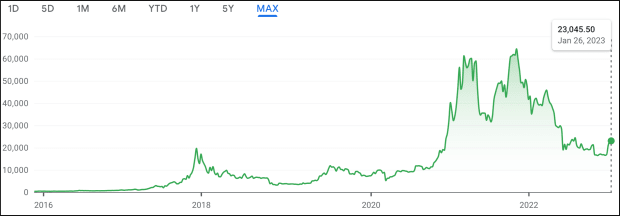What Is a Crypto Winter? Definition, Length & Investor Impact
Although cryptocurrency is a younger asset class, its overall performance seems to be somewhat cyclical—just like its more established peers. In other words, it experiences booms and busts in a similar fashion to more traditional securities like stocks and bonds. Despite being younger than most ...


Although cryptocurrency is a younger asset class, its overall performance seems to be somewhat cyclical—just like its more established peers. In other words, it experiences booms and busts in a similar fashion to more traditional securities like stocks and bonds.
Despite being younger than most members of Generation Z, cryptocurrency has already experienced several major peaks and troughs characterized by high trading volume, wild volatility, and unfathomable gains and losses for those involved.
What Is a “Crypto Winter?” Where Did the Term Come From?
When the value of the cryptocurrency market as a whole recedes by a significant percentage for a sustained period—usually led by major players like Bitcoin and Ethereum—many investors describe the downturn as a “crypto winter.” A crypto winter is essentially the digital-currency equivalent of a bear market in equities.
The term was coined by South African data analyst and digital-asset enthusiast Eugéne Etsebeth in 2018. At the time, Bitcoin, the most popular cryptocurrency and largest by market cap, had tumbled from a 2017 peak of nearly $15,000, eventually bottoming near $3,500 in early 2019.
Many have speculated that the inspiration for the term may have come in part from the popular HBO fantasy series, Game of Thrones, in which the concept of an impending winter of unusual length and severity is a central motif.
How Long Do Crypto Winters Last?
If cryptocurrency behaves like other asset classes (which it seems to, but with even more volatility), then crypto winters, like bear markets, likely come in all shapes and sizes. Since crypto hasn’t been around all that long, we don’t have that much data to look at.
The crypto winter that led to the coining of the term lasted almost three years, from early 2018 to late 2020. At that point, crypto began to skyrocket, with Bitcoin topping out above $60,000 in mid-march 2021.
A much shorter fall in crypto prices followed, lasting from early May to mid-August of the same year. This downturn was so shortlived, however, that some would probably hesitate to call it a true crypto winter, instead dubbing it a simple pullback (which is interesting because this downturn was very close to a real winter’s length of around 4 months).
The crypto market began to tumble again in late 2021, with Bitcoin falling from a mid-November high of almost $65,000 to a low of around $17,000 in mid-November of 2022. As of late January 2023, the crypto market had yet to recover.
A Timeline of Crypto Winters
- Early 2018 to late 2020 (~3 years)
- Early May to mid-August of 2021 (~3.5 months)
- Early 2022 to present (1 year and counting)

What Causes Crypto Winters?
Like most large-scale phenomena, crypto winters don’t have a singular cause, and different crypto winters have probably resulted from different circumstances. That being said, there are a number of factors that could reasonably be expected to contribute to a downturn in the crypto market.
- Inflation and rising interest rates: When the rate of inflation rises, and the Federal Reserve raises interest rates in response, investors tend to move their money away from riskier investments like tech stocks and crypto and into safer, interest-paying assets like bonds and preferred stock. This leads to a drop in the prices of those riskier assets. Rising interest rates and general economic malaise are probably among the top contributors to crypto downturns.
- Scandals and negative press: When something untoward occurs in the realm of crypto (scams and scandals aren’t uncommon in decentralized finance due to how little regulation cryptocurrencies are subject to), investors take notice, and this can affect crypto prices.
- Capitulation: Despite the original purpose of cryptocurrency as a store of value to be used like a currency, most individuals and institutions treat crypto as an investment, and investors are notoriously emotional. When the value of any investment begins to fall, a “herd mentality” can easily take hold of investors who are still long in the asset, triggering a wave of capitulation. As prices fall, more investors panic and sell, causing prices to fall further, and so on until demand and supply reach eventually reach relative equilibrium.
How Do Crypto Winters Impact Investors and Institutions?
The most obvious impact of a crypto winter is the financial loss suffered by investors, both individual and institutional. During each crypto winter, DeFi evangelists whose portfolios are tied up almost exclusively in cryptocurrency experience devastating blows to their net worth, while investors with more diversified portfolios experience subtler losses depending on their asset allocations.
Job losses and business closures are another consequence of prolonged downturns in the crypto market. During crypto bull markets, many new businesses tend to emerge in the realm of decentralized finance—mostly mining operations and digital exchanges. The allure of the “digital gold rush” is hard to pass up, and young companies poised to take advantage of the booming industry abound.
When crypto values plummet and remain low for sustained periods, however, smaller and newer mining companies and exchanges frequently go bust, and larger, more established operations have to cut costs by instituting mass layoffs.
Examples of Layoffs at Crypto Companies
- Robinhood, a popular crypto (and stock) trading platform, laid off 8% of its workforce in April of 2022 and an additional 23% in August of the same year.
- Coinbase, one of the most popular and well-established crypto exchanges laid off 18% of its staff in June of 2022.
- Hodlnaut, a popular crypto-lending platform, slashed its workforce by a massive 80% in August of 2022.
- In January of 2023, Crypto.com announced that it was laying off 20% of its staff.
When Will the Current Crypto Winter End?
Bitcoin began to fall from a high of around $65,000 in November of 2021. About a year later, in November of 2022, it reached a low of around $16,000. As of late January 2023, it has rebounded to around $23,000.
But will the current crypto winter come to an end? Or will prices keep plummeting until the market collapses altogether? Because crypto is such a young industry, and so many financial professionals decry digital currencies for lacking “intrinsic value,” it’s certainly possible that cryptocurrencies could continue to lose value and eventually fall out of favor altogether.
On the other hand, so many individuals, companies, and institutions have money tied up in the crypto world that once interest rates fall and inflation stabilizes, the industry (or at least the major players like Bitcoin and Ethereum) could see a massive comeback. According to TheStreet’s Luc Olinga, “While optimism seems to have returned, cryptocurrency prices are still far from their records set in the midst of the crypto craze at the end of 2021.”
What's Your Reaction?



























































